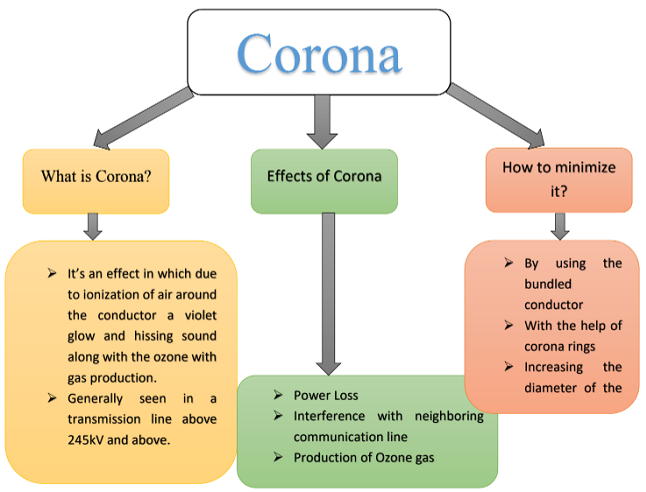
Nowadays, the Corona is a very trending topic, but in the power system, the corona exist
from a long back ago.
Anyways let’s comes to the point- corona in power system.
Table of Contents
What is the corona effect in power system?
The corona is a phenomenon in which the discharge of ions takes place. As we know the air is a dielectric medium which having an electrical field strength of about 30kV/cm.
When a two-line of high voltage transmission (likely above 245kV) spaced at some distance apart may cause the ionization of the air particles and that leads to the formation of the arc between these two conductors and a violet glow appear to our naked eye this scenario is referred as a ‘corona‘ in power system.
What are the factors affecting Corona?
Corona power loss is more frequent in humid weather conditions.
Corona depends on other factors such as system frequency, air density, air conductivity, load current, system voltage, conductor radius, and atmospheric condition. These are the above factors affecting corona loss in transmission lines.
The corona phenomenon can be observed by:
- The hissing noise comes, when you closed to the transmission line.
- A violet glow appears to our naked eye in the form of arc film.
Corona power loss calculation
There are various terms associated with the corona power loss formula.
- Critical Disruptive Voltage:
The critical disruptive voltage is the minimum value of voltage for which corona occurs.
- Visual Disruptive Voltage:
The visual disruptive voltage is voltage for which the corona will view in the form of violet glue.
The empirical formula of corona loss is as follows:

Where,
Vd- Critical disruptive voltage (phase voltage)
Vph- System phase voltage
r- Conductor radius
d- Conductor diameter
δ- Air density factor (Its value depends on the surrounding temperature)
The critical disruptive voltage (Vd) is given by-

Where,
m- air density factor
g- dielectric strength of air (standard 30kV/cm)
r- radius of the conductor
d- distance of spacing between the conductor
How to reduce corona effect?
Basically, two methods can be reduced the corona effect in transmission lines.
1. By using the bundled conductor-
As the geometric mean distance increases so overall diameter is increases as well as area. So electrical fields get distributed and the ionization of the air is avoided up to a certain extend.
2. Increasing the spacing between the conductor-
As the potential difference between the conductor is going to increase so the voltage at which corona occurs is also increases.
But this is not the right practice as it has some limitations.
Disadvantages of corona effect in transmission line
The corona effect has following disadvantages such as …
- Results in power loss, so ultimately efficiency will be reduced.
- It creates interference in the neighboring communication line.
- Hissing noise would cause earache for those who lived near to the transmission line.
- Ozone gas formation leads to pollute the atmosphere.
Corona can be summarized from the following picture.

Read some related tutorials: